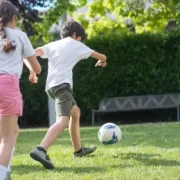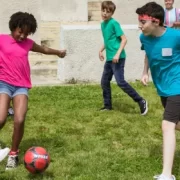Basic Soccer Rules are as Simple as How to Play Soccer
Playing soccer at your home and playing at the field are two very different things. So, if your kid has a keen interest in professionally learning soccer then you must pay the best attention to the soccer rules.
Although the rules seem to be a lot and complex, they are nothing more than how to play soccer. So, here we will be elaborating on the basic soccer for toddlers rules that you must know and teach your kid.
All the basic soccer rules about how to play soccer that you need to teach your kids
Whether it is soccer for adults or soccer for toddlers there are a lot of rules that stay the same for all levels. Moreover, these rules can be divided into different categories for better and easier understanding.
So, here are the basic rules for soccer that are followed by soccer clubs in San Antonio as they are followed all around the world as well because of being held by FIFA.
Rules regarding the field
When the kid has to play soccer professionally the first thing you need to tell them is the rules regarding the field. So, they know everything right from the start.
Speaking of the size of the field where players are in a soccer game of 11 vs 11, the standard size for the field must be 120 yards in length with 80 yards in with
Rules regarding the ball
Now comes the ball. There are different sizes of the ball that are used to play games of soccer. In soccer training for kids the best way to get a size 3 ball as it provides the best kicking and ball control experience for the kid.
As the kid grows the ball size can be changed. So, whether it is about using ball size 5, 4, or 3 it must be according to the age of kids.
Rules regarding players
When it comes to the players, the kid must know everything that will be going on inside the field. There are two teams with a maximum of on-field players of 11 including the goalkeeper.
However, it is important to note that all of the games are not played by the team of 11 as sometimes teams are reduced to 8, 6, or even 5 depending on the type of game.
-
Substitutions
Another important thing about the players for soccer training is that the team may have more than the playing players. Those are known as substitutions.
These are the players that either come in the game after some time as a replacement for some other player. Or they play some matches and not all. An important thing is that one team is only allowed 5 substitutions per game.
Soccer game rules
When it comes to the game rules of soccer training there are a lot of things that the kid needs to know. So, we will start right from the start of the game and proceed as the game proceeds.
-
Start of the game
The game starts from the middle of the field. Here two players of a team pass the ball as the referee signals. According to the latest rules, there are no directional limitations about passing the ball as the game starts.
-
Game in play
As soon as the game starts according to the signal from the referee the game is in play, and it stays in play until there is a signal from the referee about some game stopping condition.
The game-stopping conditions can be a goal, foul, ball out of the bounds, or anything else. So, the game stays in play as long as the referee does not stop the play.
-
Game duration
According to the rules, a basic soccer game of 11 vs 11 players is no more than 90 minutes. There are two halves of 45 minutes each with a break for about 15 minutes between each half.
Things are a little different for kids soccer training as the game can range between halves from 15 to 30 minutes with a break between them lasting for 7 to 10 minutes.
Dealing with the ball
An important rule to follow when the game is in play is that there must be no hands on the ball. The players can use any part of the body including the shoulders.
In some cases, if the arm is touching flush with the body, then there is no issue, otherwise touching the ball with arms is also considered a foul.
-
Out of bounds
There are the boundaries of the field which are checked by the linesman referee. As long as the ball stays within those lines the game is in play. As soon as the ball goes out of those lines as signaled by the referee the game is stopped.
The thing to note here is that the team that makes the last touch on the ball does not get to throw the ball. The opponent team throws the ball inside the field again to continue the game.
-
Throw-in
The rules for a throw-in include the ball being thrown in from the point at the line where it went out. The offside rules do not apply on the throw-ins while the ball can is thrown indirectly to score a goal. Additionally, both feet must have contact with the ground when the ball is thrown.
Another important thing is that the ball must be held by both arms and the arms can move from the front to back only over the head. Side throws are not allowed.
-
Goal
When the attacking team makes the ball pass by the goal line, it is considered a goal. However, if the final kick is from the attacking team but the ball goes out without any of the defending team’s players touching the ball then it is a goal kick. Similarly, if the defending team sends the ball out from their side, then it is a corner kick.
Rules regarding fouls
The following are some of the fouls:
- Pushing
- Handball
- Vulgar behavior
The result of any of these fouls can be:
- Red or yellow card
- Free kick
- Penalty kick
The free-kick location and placement are decided by the referee.
Conclusion
Knowing the basic soccer rules can change the way your kid plays the game. Here we were discussing the most basic soccer rules that every kid must know. So, whether your kid is going to any soccer club for training or not you must make them aware of these basic rules.








